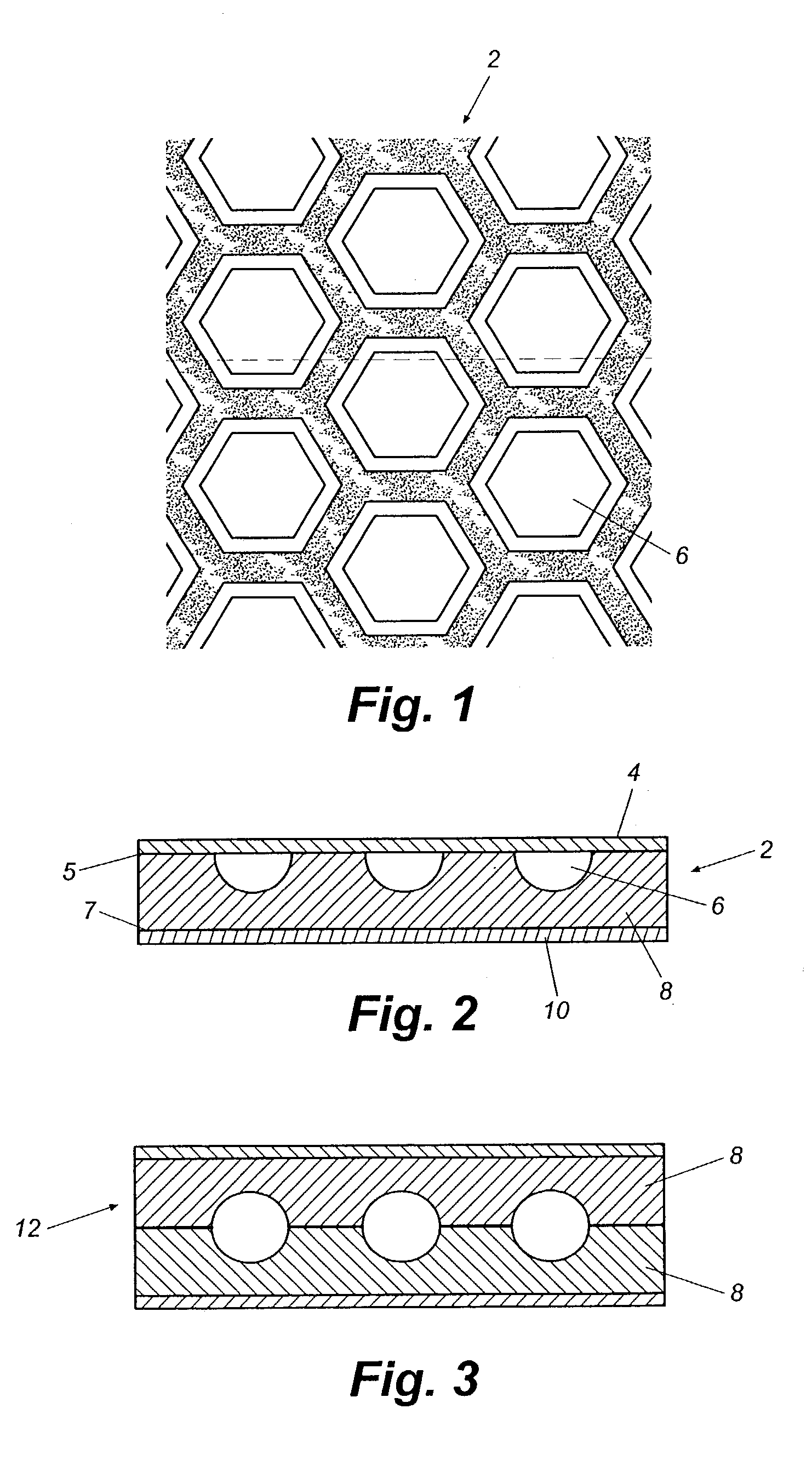Acoustical panel having a honeycomb structure and method of making the same
a honeycomb structure and acoustic panel technology, applied in the field of acoustic panels, can solve the problems of health and environmental concerns, use of fiberglass, and cost of fiberglass relative to natural fibers, and achieve the effects of improving the sound quality of the acoustic panel, improving the sound quality, and improving the sound quality
- Summary
- Abstract
- Description
- Claims
- Application Information
AI Technical Summary
Benefits of technology
Problems solved by technology
Method used
Image
Examples
example 1
Formulation 4
[0034]
Front Cavity PercentageNRC (Scrim)NRC (Back) 0%0.660.7010%0.710.7217%0.670.7326%0.690.6937%0.680.6850%0.660.7070%0.640.71
[0035]Applicants believe that the data produced from Example 1 reveals little variation in acoustical values as related to the diameter or void volume of the cavity.
[0036]In Example 2, Applicants evaluated the overall effect of the thickness of the backing with regard to acoustic performance. In this Example, a ⅜ inch thick layer 8, having the various depressions 6, therein integral with the foamed, cementitious composition, having a thickness of 0 to ⅜ inch as measured from the bottom of the cell depressions to the planar first surface was varied. A fiberglass scrim was applied over the depressions on a first surface of layer 8. NRC values in the table below for Example 2 note whether the sound was directed at the scrim or at the planar backside of the gypsum foam. The data reveal some dependence of NRC on the direction from which the sound app...
example 2
Formulation 4
[0037]
Backing ThicknessScrimBack01.001.00 1 / 160.830.84 1 / 8 0.780.78 1 / 4 0.790.70 3 / 8 0.720.59
[0038]Example 3 below illustrates an additional test of the same material of Formulation 4 to confirm that the scrim covered honeycombed face is more acoustical than the continuous back face. For Example 3, Applicants utilized a reverberation room test that conforms to the following standards: ASTM C423-90a, E 122, E 548, E 795; ANSI S1.6, S1.26, S.1.11; and ISO R 354-1963. Applicants also conducted an airflow test that conforms to ASTM D 737 standards. Additionally, Applicants conducted Sound Transmission Coefficient (STC) tests having results determined by an insertion loss as set forth in ASTM E 90.
example 3
Formulation 4
[0039]
NRCAir Flow(reverb room)(ohms)STCHoneycombScrimBackScrimBackScrimBack30 lb / cuft0.480.382163435
[0040]Another property for examination was the density of the gypsum foam used for the layer 8. In Example 4, Applicants controlled the density to some extent by varying the amount of water added to the mixture. A greater weight percentage of water results in a lower density foam, when the foam is dried. All samples of the layer 8 were ⅝ of an inch thick, without depression 6. The relationship between the density and acoustical properties is most significant as demonstrated in the table for Example 4 below. The greatest acoustical absorbency occurs between the density ranges from 17 to 25 pounds per cubic feet.
PUM
| Property | Measurement | Unit |
|---|---|---|
| thickness | aaaaa | aaaaa |
| thickness | aaaaa | aaaaa |
| size distribution | aaaaa | aaaaa |
Abstract
Description
Claims
Application Information
 Login to View More
Login to View More - R&D
- Intellectual Property
- Life Sciences
- Materials
- Tech Scout
- Unparalleled Data Quality
- Higher Quality Content
- 60% Fewer Hallucinations
Browse by: Latest US Patents, China's latest patents, Technical Efficacy Thesaurus, Application Domain, Technology Topic, Popular Technical Reports.
© 2025 PatSnap. All rights reserved.Legal|Privacy policy|Modern Slavery Act Transparency Statement|Sitemap|About US| Contact US: help@patsnap.com


